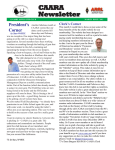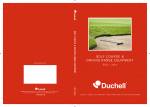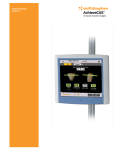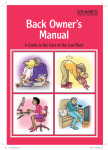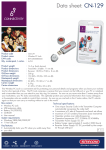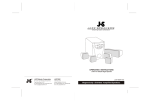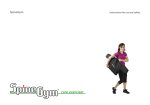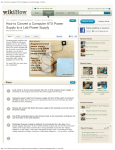Download the user manual
Transcript
STRETCH STRENGTHEN STABILIZE IMPROVE YOUR POSTURE. IMPROVE YOUR HEALTH. Every BODY Needs One Your incredible anatomy and healing capabilities. Your Spine Your spine is made up of 24 vertebrae that together with the intervertebral discs, make a flexible column. Running through this column is a cable of nerves called your spinal cord. These nerves transmit messages between your brain and the rest of your body. If these nerves become compressed or irritated, the message they transmit is “pain”. More importantly, however, poor spinal health can negatively affect major organs and other systems. Poor posture can lead to spinal degeneration, nerve compression and the wasting away of muscles that support your back and core. Back pain is the leading cause of disability in adults aged 30 to 50. Your Neck In addition to providing you with the ability to tilt, turn and bend freely, your neck houses many vital anatomical structures. These include: • 7 cervical vertebrae (neck bones) • spinal cord and nerves • glands (including your thyroid & parathyroid) • voice box, esophagus & trachea • muscles, ligaments & blood vessels Proper posture involves your neck and your head just as much as your spine. Holding your head and neck too far forward or backward can adversely affect these neck structures and create problems throughout the rest of your body. Your Healing Ability Your body has an incredible capacity to regulate and heal itself. So the good news is that any postural damage you may have done through bad habits or a modern lifestyle, can probably still be corrected. Take an active role in improving your posture by spending just a few minutes a day to stretch, strengthen and stabilize Correcting your posture can dramatically affect your overall health and well being. BEFORE AFTER Improving your posture can: • Reduce pain in your back and neck • Increase blood flow to and from the heart • Reduce blood pressure and increase circulation • Improve breathing and diaphragm function • Open throat and windpipe • Reduce stress on lower and upper back • Increase range of motion • Improve nerve signals from the spine • Reduce fatigue and positively impact sleep • Promote proper growth development in children • Reduce the likelihood of spinal conditions such as herniated discs • Reduce pressure to kidneys, stomach, colon & other internal organs • Improve cerebrospinal (brain stem) fluid flow • Reduce dizziness, headaches and “pins & needles” • Reduce the risk of osteoarthritis and other types of joint damage Every BODY Needs One • • • • • Immediate results Most ages & abilities Use & wear anywhere Use for rehab or pre-hab Five sizes, two strengths Car Office Home Stretch • Strengthen • Stabilize One Simple Tool Does it All Where do you stand? Noodle Nosey Goose Correct Posture Baby on board Hipster On Guard Our bodies were not designed for our modern lifestyle. Our physical evolution did not prepare us for long periods of sitting and inactivity. Most people do not maintain proper posture while using a computer, driving, watching television, walking, standing or during other daily activities. Poor posture arises for two main reasons: Tight Tonic Muscles - Your tonic muscles are responsible for holding your posture. They can constrict and tighten making it more difficult to achieve and maintain correct posture. Weak Phasic Muscles - Your phasic muscles are used for dynamic movement. They can weaken and lengthen, making you more prone to slouching. TONIC PHASIC To offset our modern lifestyle, we need to actively care for our postural muscles. The Posture Medic was created for this purpose. We cannot simply rely on being conscious of our poor posture. Periodically remembering to sit or stand up straight will not create lasting effects. We need to stretch, strengthen and stabilize the region in order to correct poor posture. Every BODY Needs One All Abilities The Posture Medic is recommended for anyone that sits or stands for long periods at a time or does repetitive movements. It can be used practically anywhere and by people with every level of physical ability. Use the “Implementation Program” included in this booklet to gradually improve your postural health and overall strength. All Ages CHILDREN Kids today face a variety of issues that can lead to poor postural health. They often carry over loaded backpacks, sit incorrectly for long periods in front of a computer or video game and are generally less active than previous generations. Incorporating the Posture Medic into a childs routine may help prevent postural problems before they become more serious conditions. The Posture Medic is recommended for anyone over the age of 12 that meets the minimum height and weight of the sizing chart. Younger children may also be able to fit the Posture Medic but they should be closely monitored to assure they use the product safely. Add Posture Medic to your regular family fun days. SENIORS It’s never too late to improve your posture. If existing conditions prevent you from completing the exercises as shown, they can be modified by your healthcare provider to suit your needs. Wearing a Posture Medic during daily walks and activities can help you get back on track. Stabilize BEFORE AFTER Start by wearing the Posture Medic in 15 minutes intervals, 2 - 3 times per day. You will graduate to longer periods as you improve. Assuring you have the correct size of Posture Medic is essential. A sizing chart is provided on the back cover which is based on average chest circumferences. If you are close to a larger size and have a larger chest, we suggest you move up a size. 1 Start with your hands at your side, holding the Posture Medic behind you. Make sure your palms are facing out, then grip the handles. 2 Slowly raise your hands while you bend your elbows and slide them through the rings. 3 Bring the handles to the front of your shoulders. Adjust the brace so that it sits comfortably centered between your shoulder blades. To remove your Posture Medic, apply the same steps in reverse order. • Do NOT continue to wear if you have any tingling in your arms, pain or pinching (immediately remove). • Do NOT expect the Posture Medic to fix your posture just by wearing it. It will remind you to maintain proper posture BUT you must do the stretches and exercises to gain long term success. • The Posture Medic is not a toy. Children under 12 should be closely monitored if using the device. Implementation Program STRETCH STRENGTHEN STABILIZE WEEK 1 2 - 3 reps Repeat 2 - 3 times per day NONE Wear 15 minutes Repeat 2 - 3 times per day WEEK 2 3 - 4 reps Repeat 3 - 4 times per day NONE Wear 20 minutes Repeat 3 - 4 times per day WEEK 3 4 - 5 reps Repeat 4 - 5 times per day 10 reps 2 - 3 times per day Wear 20 minutes Repeat 4 - 5 times per day WEEK 4 INACTIVE No matter what you consider your condition to be, we strongly suggest that you start slowly and build to maximum effect by following our programs. Should you feel any unusual discomfort during the exercise program, stop and consult your healthcare professional. They may modify exercises or stretches for your specific condition. 5 reps Repeat 5 times per day 20 reps 3 times per day Wear 30 minutes Repeat 5 times per day WEEK 1 5 - 10 reps Repeat 5 times per day 20 reps 3 times per day Wear 20 - 30 minutes Repeat 2 - 3 times per day WEEK 2 10 reps Repeat 5 times per day 20 - 30 reps 4 times per day Wear 30 minutes Repeat 5 times per day WEEK 3 10 reps Repeat 5 times per day 30 - 50 reps 5 times per day Wear 30 minutes Repeat 5 times per day WEEK 4 ACTIVE You are now ready to advance to Active. 10 reps Repeat 5 times per day 50 reps 5 times per day Ad Needed WEEK 1 2 - 4 reps Repeat 2 - 3 times per day 10 - 20 reps 2 - 3 times per day Wear 15 minutes Repeat 3 times per day WEEK 2 3 - 5 reps Repeat 3 -4 times per day 20 - 30 reps 3 - 5 times per day Wear 20 minutes Repeat 4 times per day WEEK 3 5 reps Repeat 4 times per day 30 reps 5 times per day Wear 30 minutes Repeat 5 times per day WEEK 4 ATHLETIC You can either maintain your level at Active or move to Athletic with the Posture Medic PLUS design. As Needed 30 reps or more 5 times per day As Needed Stretch • Keep your back and shoulders straight • Relax your shoulders and neck muscles • Never force a stretch STABILIZER HANDLE These names will be used throughout the stretch and strengthening exercise descriptions. Stretch #1- Neck Stretch ATTENTION: Try this stretch without using the Posture Medic first. Most users will not require the Posture Medic to receive a sufficient stretch. If you are very flexible, add the Posture Medic as instructed. 1 1 Start by holding the Posture Medic in front of you by the handles shoulder width apart. Raise your arms above and over your head to rest the stabilizer on the back of your head. Gently pull the handles forward until the Posture Medic is secure. 2 2 Gently pull forward and down on the handles, guiding your chin down to your chest. Do NOT engage your neck muscles to resist the movement. Stop when you feel resistance. Hold for 10-15 seconds. Slowly release pressure on the handles and raise your head to an upright position. TIPS • Stand with your feet shoulder width apart • Relax and lower your shoulders 2 1 Stretch #2- Lat Stretch 1 Begin with both arms directly over your head holding your Posture Medic with palms facing out. 2 Slowly lean to one side until your feel the stretch. Hold for 10 to 15 seconds. Come back to the centre and repeat on other side. Stretch #3- Shoulder Stretch 1 Begin with palms facing out and Posture Medic directly behind you. 2 Slowly raise your hands towards the ceiling. Keep your chin tucked in and push your shoulders back. 2 Hold for 10 to 15 seconds then slowly release and return to starting position. 1 TIPS • Stand with your feet shoulder width apart • Relax your neck and shoulder muscles • Keep your upper back and shoulders straight Stretch #4- Upper Traps Stretch 1 ATTENTION: Try this stretch without using the Posture Medic first. Most users will not require the Posture Medic to receive a sufficient stretch. If you are very flexible, add the Posture Medic as instructed. 1 Start by holding the Posture Medic over your head with your palms facing in. Slowly bring one of your elbows down and across your body so the stabilizer is centered on your ear. 2 2 Slowly bend your head sideways bringing your ear towards your shoulder. Carefully pull the Posture Medic handles to increase the stretch. Do NOT engage your neck muscles to resist the stretch. Once in position, relax your neck muscles and hold for 10 to 15 seconds. Complete the set on one side before doing the opposite side. Strengthen • Plant your feet shoulder width apart • Relax your shoulders and keep your back straight Strengthen #1- Rear Delt Fly 1 Begin with your arms straight in front of you, hold- 1 ing the Posture Medic with your palms facing in. 2 Squeeze your shoulder blades together and spread your hands apart. Hold for 3 seconds. Keep your wrists, elbows and back straight. 2 Slowly release your arms to return to the starting position, keeping resistance on the Posture Medic throughout the exercise. Strengthen #2- External Rotation 1 1 Begin with arms at a 90 degree angle directly to your side with palms facing in. 2 Keeping elbows tucked to your side, slowly squeeze your shoulder blades together and rotate your hands to the side. Go as far as your body will allow you without moving your elbows from your side. Hold for 3 seconds. Slowly bring hands back to starting position. 2 TIPS • Plant your feet shoulder width apart • Relax and lower your shoulders • Keep your back straight with your core engaged Strengthen #3- Rotator Cuff 1 1 Hold the Posture Medic in front of you, with your palms facing in. Slowly pull your hands wider apart and hold for 3 2 seconds. Keep your wrists, elbows and back straight. Slowly release your arms to return to the starting position, keeping resistance on the Posture Medic throughout the exercise. 2 1 2 Strengthen #4- Posture Medic Punch 1 Begin by putting the Posture Medic on and holding both handles. 2 With one hand punch forward so that your arms extends perpendicular to your body. At the end of the punch, stretch your shoulder blade forward. Hold for 3 seconds. Slowly return to the starting position. Repeat on the opposite side. Things to Keep in Mind Now that you plan to stretch, strengthen and stabilize yourself to better posture, here are some important things to keep in mind. Extended Standing Standing still for over 20 minutes at a time can can have a negative impact on your musculoskeletal system. Standing properly to balance and distribute your weight evenly begins with your feet. Proper footwear is key. You should find shoes that support your feet properly while still being safe and/or work appropriate. Make sure that your shoes fit properly, have a soft sole and provide good arch support. You can also modify your existing shoes by adding a custom orthotic or over the counter arch supporting insole. If your job requires you to stand all day, ideally it is not on a hard surface. Using an “anti-fatigue mat” can reduce the strain. While standing, pull your naval towards the back of your spine and tuck your hips under. Stand tall and keep your chin tucked in - do not stick it forward. Be sure to shift your position regularly so that your muscles do not get stiff. It may also be helpful to occasionally stand with one foot on a stool to relieve the pressure on your back. Prolonged Sitting Whether it’s at a desk, on a couch or in a vehicle, we often spend too many hours sitting continuously throughout the day. In addition, most of these seats are not designed to support our neck and back correctly for such extended periods. Driving Posture Allowing your car’s seat to properly support you can greatly reduce the stress on your spine. • Recline the seat back 10-15 degrees from the vertical. Add a lumbar cushion if required. • Tilt the seat to as near to horizontal as possible. • Slide the seat forward so you can comfortably press the foot pedals and reach the steering wheel. • Relax your shoulders and avoid gripping the steering wheel too tightly. Computer Posture If you are purchasing a new office chair, select one with both adjustable seat height and armrest height. It should also have a padded seat that is at least 3 cm wider than you hips and thighs. For proper alignment, there are three main points: • Spine: Line up your hips with your shoulders, and your shoulders with your ears • Shoulders: Keep your upper arms relaxed and close to your body • Wrists: Keep in line with your lower arms The back of your knees should rest 2-3 finger widths from the seat cushion. Your elbows should be bent at a 90 degree angle with your arms supported and your wrists resting comfortably on your keyboard. 1. Screen slightly below eye level 2. Body centered to both the monitor and keyboard 3. Forearms level or tilted up slightly 4. Lower back support by chair or lumbar cushion 5. Wrist should not rest when you type 6. Legs horizontal to the floor 7. Feet flat on the floor or resting on footrest Laptops By their very design, laptops pose unique problems. Either your neck has to remain bent in order to see the screen, or your wrists sit at an awkward angle for typing. If your primary computer is a laptop, add an external monitor and keyboard where you use it the most often. Video Games Enthusiastic gamers often have even more destructive posture practices than computer users. Ideally gamers should follow the same seating principles outlined for computers, however if that is not practical, sitting in a recliner in front of the television with your legs up is more ergonomic. Sleeping Sleeping is often overlooked as part of postural health. We spend about a third of our lives sleeping and our sleep posture can put a lot of strain on our back and neck. A supportive mattress and pillow will improve the quality of your sleep and allow you to wake pain free. There are three main sleep postures: Back Sleepers To create proper support for back sleepers, you will need a pillow that offers firm support at the neck but allows the back of your head to drop back. Orthopedic pillows often have divots or contours in the centre for this purpose. Soft, fluffy pillows do not provide any cervical support. The fill simply moves away from the area or is compressed when pressure is applied. To relieve tension in your lower back, back sleepers should try putting a pillow under their knees. Side Sleepers Side sleepers need to accommodate the gap between your head and shoulder. Your neck should remain at a 90 degree angle from the line of your shoulder (as depicted above). If you typically need to put your arm under your head or use two pillows, its time to get a new pillow. For side sleepers size really matters. The pillow should not allow your neck to flex up or tilt down. When sleeping on your side, your knees should be aligned with one another to keep your hips straight. If you are slim, try putting a small pillow between your knees to space them apart. Pillow Test Stomach Sleepers There is really no correct way to sleep on your stomach, so it should be avoided if at all possible. If an injury prevents you from sleeping in another position, then the trick will be to keep your neck aligned with your spine as much as possible. Try not using a pillow at all. With the pillowcase off, fold your pillow in half. If it does not spring back into shape instantly, its time for a new pillow. Improve Your Posture. Improve Your Health. www.posturemedic.com Original Strength LIGHT BLUE X-Small RED Small GREEN Medium YELLOW Large BLACK X-Large PLUS Strength PURPLE Small BLUE Medium SILVER Large ORANGE X-Large Size chart does not factor in oversized chest girth. Original Strength Posture Medic is recommended for most individuals. PLUS Strength is recommended for athletes or those individuals who are regularly engaged in strength training. A healthcare provider should be consulted before you begin any exercise or stretching regimen. Safety Precautions: The Posture Medic is not a toy. Keep away from children under the age of 12 years old. The Posture Medic is designed to be used ONLY as detailed in this instruction manual.

















